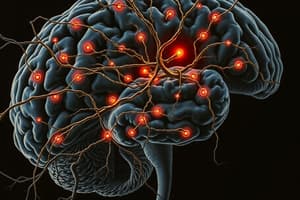Podcast
Questions and Answers
What are the two main subsystems of the nervous system?
What are the two main subsystems of the nervous system?
- Spinal Neurosystem and Extending Nerve Network
- Brain System and Body System
- Central Processing System (CPS) and Peripheral Information System (PIS)
- Central Nervous System (CNS) and Peripheral Nervous System (PNS) (correct)
What are neurons?
What are neurons?
- Blood vessels in the brain
- Digestive enzymes in the stomach
- Specialized cells for processing information (correct)
- Muscles responsible for body movement
How do neurons transmit information?
How do neurons transmit information?
- Via light impulses
- Through electrical and chemical signals (correct)
- Using sound waves
- By releasing hormones
Where do electrical signals in neurons originate?
Where do electrical signals in neurons originate?
What are neurotransmitters in neurons?
What are neurotransmitters in neurons?
Which part of the nervous system functions as the body's control center?
Which part of the nervous system functions as the body's control center?
What is the function of sensory neurons?
What is the function of sensory neurons?
Which part of the brain is responsible for movement control?
Which part of the brain is responsible for movement control?
What is the role of the autonomic nervous system?
What is the role of the autonomic nervous system?
Which neural pathway is responsible for knee-jerk reflexes?
Which neural pathway is responsible for knee-jerk reflexes?
What is the main function of the spinal cord?
What is the main function of the spinal cord?
How does the sympathetic nervous system differ from the parasympathetic nervous system?
How does the sympathetic nervous system differ from the parasympathetic nervous system?
Flashcards are hidden until you start studying
Study Notes
Understanding the Human Nervous System
The human body, with its intricate design, relies on a complex network of cells and pathways to process information, coordinate actions, and respond to our environment. In this exploration of human anatomy and physiology, we delve into the marvel of the nervous system.
The Nervous System's Components
The nervous system is composed of two main subsystems:
- Central Nervous System (CNS): This consists of the brain and spinal cord, which function as the body's control center.
- Peripheral Nervous System (PNS): This includes all the nerves and neurons that extend beyond the CNS, connecting it to the rest of the body.
Neurons: Information Processors
Neurons, or nerve cells, are the primary building blocks of the nervous system. They transmit information in the form of electrical and chemical signals, relaying messages between the body and the brain. Neurons come in various shapes and sizes, each specialized for a specific purpose.
Signal Transmission: Electrical and Chemical Methods
Neurons communicate using two primary methods:
- Electrical signals (Action potentials): Neurons use electrical signals to transmit information. These signals originate in the cell body, travel down the axon, and produce chemical signals at the synapse.
- Chemical signals (Neurotransmitters): Neurotransmitters are chemical messengers that carry information from one neuron to another across a synapse. Over 100 different neurotransmitters have been identified in the human body.
Neural Pathways and Reflexes
Sensory neurons transmit information about sensory stimuli from the body's tissues to the CNS. Motor neurons, on the other hand, transmit information from the CNS to the muscles and glands, causing muscle contractions and regulating various bodily functions.
Neural pathways and reflexes, such as the knee-jerk reflex, are examples of automatic responses that occur without conscious thought, illustrating the nervous system's ability to react quickly to external stimuli.
The Brain: A Three-Pound Computing Machine
Our brain, often referred to as the "command center" of the nervous system, is a complex organ divided into specialized regions. These regions include the cerebral cortex, cerebellum, and brainstem, each responsible for various functions such as reasoning, movement control, and consciousness.
The Spinal Cord: Information Hub
The spinal cord is a long, cylindrical structure that connects the brain to the rest of the body. It plays a crucial role in transmitting sensory information and controlling motor function. The spinal cord is also responsible for reflexes and the stability of our posture.
The Autonomic Nervous System: The Body's Invisible Regulator
The autonomic nervous system regulates involuntary functions such as heart rate, blood pressure, and digestion. It is divided into the sympathetic nervous system and the parasympathetic nervous system, which work together to maintain the body's homeostasis and help the body adapt to various situations.
Understanding the human nervous system can provide a greater appreciation for the intricate design of our bodies and the complexity of its functions. This knowledge can also deepen our understanding of various medical conditions and treatments that affect the nervous system.
Studying That Suits You
Use AI to generate personalized quizzes and flashcards to suit your learning preferences.




